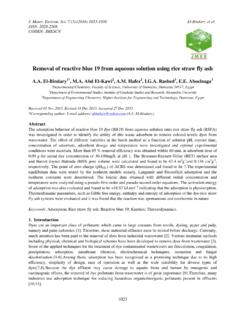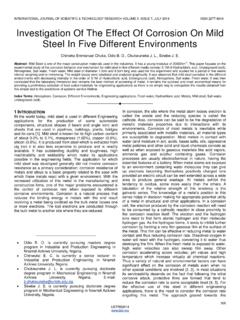Transcription of Pitting corrosion evaluation of austenitic stainless steel ...
1 J. Mater. Environ. Sci. 4 (4) (2013) 448-459 Loto ISSN : 2028-2508. CODEN: JMESCN. Pitting corrosion evaluation of austenitic stainless steel type 304 in acid chloride media Loto*. Department of Chemical and Metallurgical Engineering, Tshwane University of Technology, Pretoria, South Africa Received Dec 2012, Revised 1 Feb 2013, Accepted 1 Feb 2013. *E-mail address: Abstract The resistance of austenitic stainless steel type 304 to Pitting corrosion was studied in solutions of sulphuric acid (2M and 5 M) with and without sodium chloride addition by linear polarization technique. The Pitting and passivation potentials, corrosion rate and current density were analyzed with respect to the chloride ion concentration. Under anodic polarization the stainless steels in sulphuric acid solution acquired a passive state, with breakdown at the transpassive region ( Pitting potential), however this was greatly reduced with the addition of sodium chloride which led to a sharp increase in current at potentials signi cantly lower than the value that necessitates Pitting in the acid media due to rapid breakdown of the passive lm and development of local pits.
2 Results obtained establish the dynamic relationship and interaction between the sulphate/chloride ion concentration and electrochemical potentials in the corrosion behavior of the ferrous alloy at ambient temperature. Keywords: Pitting , corrosion , stainless steel , Sodium Chloride, Sulphuric acid Introduction corrosion causes a variety of problems, depending on the conditions under which engineering alloys applied. steel corrosion is an electrochemical process, initiated by certain electrolytic conditions in the proximity of the steel member. stainless steels are generally very corrosion resistant and will perform satisfactorily in most environments. The limit of corrosion resistance of a given stainless steel depends on its constituent elements when exposed to a corrosive environment; however under exposure in certain industrial conditions stainless steel corrodes in the form of localized attacks ( Pitting ), due to inclusions or a breakdown of the passive film.
3 Pitting corrosion is an accelerated form of chemical attack in which the rate of corrosion is greater in some areas than others. It occurs when the corrosive environment penetrates the passivated film in only a few areas as opposed to the overall surface. Pit type corrosion is simple galvanic corrosion , occurring as the small active area is being attacked by the large passivated area. This difference in relative areas accelerates the corrosion , causing the pits to penetrate deeper [1]. Pitting corrosion is particularly insidious; a component can be perforated in a few days with no appreciable loss in weight on the structure as a whole. It is most aggressive in solutions containing chloride, bromide or hypochlorite ions; iodides and fluorides are much less harmful. The presence of sulfides and H2S enhances Pitting corrosion as well and systematically impairs the resistance criteria for this type of attack.
4 The presence of an oxidizing cation (Fe+3, Cu+2, Hg+2, etc.) enables the formation of pits even in the absence of oxygen. However, in the presence of oxygen, all chlorides become dangerous, and this is also true in the presence of hydrogen peroxide [2]. This form of corrosion is often more detrimental than general corrosion , due to local dissolution which can cause rapid penetration of the metal thickness. In many cases Pitting corrosion is not detected until severe damage occurs, such as complete penetration in sheet or tube material. This is due to the very small pit holes formed on the surface and to the fact that the metal surfaces in many applications become covered with precipitates from process fluids or with thick layers of more or less 448. J. Mater. Environ. Sci. 4 (4) (2013) 448-459 Loto ISSN : 2028-2508. CODEN: JMESCN. protective corrosion products. The corrosion products from a pit attack are often found to create a lid on top of the pit, with only a very small opening.
5 When examining the metal surface for pits it should therefore be thoroughly cleaned in order to reveal the pitted areas. Pitting is considered to be more dangerous than uniform corrosion damage because it is more difficult to detect, predict and design against. A small, narrow pit with minimal overall metal loss can lead to the failure of an entire engineering system. The rate of penetration may be 10 to 100 times greater than that by general corrosion . austenitic stainless steel is the largest and most important group in the stainless steel range. These steels, which exhibit a high level of weldability, are available in a wide range of compositions which are used for general stainless steel fabrications, elevated temperature applications and resistance to Pitting corrosion respectively. This material has good corrosion resistance due to the formation of passive film of chromium oxide. The film is stable, invisible, thin, durable, extremely adherent and self-repairing.
6 Passivation reduces the anodic reaction involved in the corrosion process, but quite severe Pitting corrosion can occur in acidic environments [3]. The failure of some stainless steels resulting from Pitting , corrosion is sometimes considered a technological problem [4]. Consequently, much effort has been expended in attempting to understand and overcome Pitting , corrosion , thus many stainless steel /environment combinations have been studied [5]. Perhaps the greatest research effort has been concentrated on the localized corrosion of stainless steel in chloride, bromide, chloride/sulphide, bromide/ sulphide and chloride/thiosulphate media [6-12] reflecting the preeminence of austenitic stainless steel as construction material for many industrial process plants applications. This research aims to investigate the resistance of austenitic stainless steel type 304 to Pitting corrosion in sulphuric acid +.
7 Chloride media by potentiodynamic measurement test. Experimental procedure Material Commercially available Type 304 austenitic stainless steel was used for all experiments of average nominal composition; , and The material is cylindrical with a diameter of (18mm). Test Media 2M sulphuric acid, 5M sulphuric acid, 2M and 5M sulphuric acid with (1 5) % recrystallised sodium chloride of Analar grade were used as the corrosive medium Preparation of Test Specimens The cylindrical stainless steel (18mm dia.) was mechanically cut into a number of test specimens of the same dimensions, manually mounted and ground silicon carbide abrasive papers of 80, 120, 220,800 and1000 grits. They were then polished with to diamond paste, washed with de-ionized water, rinsing with acetone before been dried and stored in a dessicator for weight-loss measurement. Weight-Loss Measurement Each experiment in weight loss measurement was carried out in a flat plastic bowl containing 200 mL of the dilute corrosive solution (sulphuric acid with and without sodium chloride) in the specified concentrations.
8 Twelve clean and previously weighed coupons were hanged and immersed vertically in the vessel. The cleaning procedure consisted of washing with de-ionized water and then rinsed with acetone. Weight loss was determined by weighing the cleaned samples before and after hanging the coupons into the acid solutions at ambient temperature after the elapsed time. The average weight loss of the coupons was taken to calculate the corrosion rate. Linear polarization Resistance Linear polarization measurements were carried out using cylindrical stainless steel coupon embedded in resin plastic mounts with exposed surface of 254 mm2. This working electrode was metallographically prepared with different grades of silicon carbide paper, then polished to 1um using diamond paste, rinsed with de-ionized water and dried with acetone prior to electrochemical analysis. The studies were performed at ambient 449. J. Mater. Environ.
9 Sci. 4 (4) (2013) 448-459 Loto ISSN : 2028-2508. CODEN: JMESCN. temperature with Autolab PGSTAT 30 ECO CHIMIE potentiostat with corrosion cell containing 200ml of the various electrolytes (test media). A graphite rod was used as the auxiliary electrode and silver chloride electrode (Ag/AgCl) was used as the reference electrode while the steady state open circuit potential (OCP) was noted. The potentiodynamic studies were made from versus OCP to + mV versus OCP at a scan rate of and the corrosion currents were registered. The corrosion current density (j corr) and corrosion potential (E corr) were determined from the Tafel plots of potential versus logarithm of corrosion current density applied current (log I). The corrosion rate r was calculated as follows * icorr * r (mm/py) = D. Where jcorr is the current density in uA/cm2, D is the specimen density in g/cm3; is the specimen equivalent weight in grams.
10 Results and discussion Polarization studies Figure 1 Schematic variation of potential E with log current density The solid line in is a schematic diagram of the variation of potential E with log Current density for austenitic stainless steel in the dilute sulphuric acid + chloride media. AB represents cathodic behaviour, BG is the active zone (anodic dissolution reaction). The metal is not passivated at its corrosion potential, B. AC and DC are Tafel-type straight lines drawn for the reduction and oxidation reactions of the normal metal dissolution (M=M++ e-). At potentials more positive than B, corrosion rate increases, and reaches a maximum at the passivation potential, G, which is often given the symbol, Epp. The transition from active dissolution occurs in the region G to J. A protective film begins to form and causes a sudden drop in corrosion current density. From J to P, the passive zone, the current density is maintained at a steady, low level, until point P.









